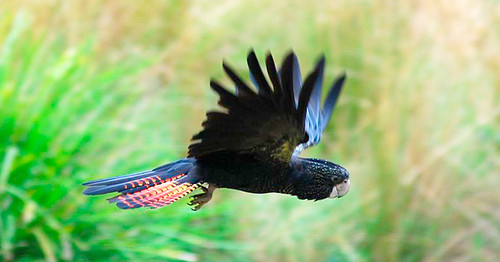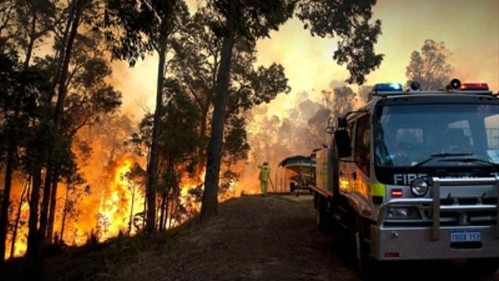Endangered species at risk from WA bushfires
 Friday, December 9, 2011 at 0:57
Friday, December 9, 2011 at 0:57 Native species of birds and mammals endemic to WA may be wiped out from raging bushfires in the region
 A red-tailed black cockatoo in flight. (Credit: Peter Campbell/Wikimedia) They are the forgotten victims of the bushfires in southwest Western Australia - species of native animals and birds that may have been completely wiped out.
A red-tailed black cockatoo in flight. (Credit: Peter Campbell/Wikimedia) They are the forgotten victims of the bushfires in southwest Western Australia - species of native animals and birds that may have been completely wiped out.
Conservationists and animal carers say populations of highly endangered possums, black cockatoos and other native species may now be locally extinct in the Margaret River, Nannup and Augusta regions.
The wildlife disaster is a result of at least two bushfires that burned through more than 70,000 hectares and destroyed more than 40 properties after a series of prescribed burns by WA's Department of Environment and Conservation (DEC) flared out of control in November.
FAWNA president Jeff Falconer, who is in charge of animal rescue efforts in the region, said this week, the fires had wiped out almost entire populations in some areas.
"Probably 90 per cent of the wildlife in those areas where the fire was fairly bad would have been killed," he said.
The combined Nannup-Augusta fire, which burnt about 50,000ha, was "the biggest on record" in WA's southwest, Jeff said.
Birds "didn't stand a chance" in Western Australia fires
Conservationists have been scathing of the decision to hold the burns in spring, during the nesting and breeding seasons, saying young animals and birds wouldn't have stood a chance.
Busselton Possum Centre president Ute Wicke said she had pleaded with the DEC two months ago not to conduct the burns during breeding season.
"We were particularly worried about the burns that get away - like we've just seen," she said.
The fires had "devastated" some of WA's healthiest populations of endangered ringtail possums around Margaret River, she added.
"At this time of the year, the possums have very vulnerable young with them - they are just out of the pouch - and they don't have a chance," she said. "So not only the adult population dies, but so does the next generation. We really feel we might have lost the best habitats and ringtails will go locally extinct in those areas."
Animals vulnerable to bushfires
Ute said the aftermath of the fires had been heartbreaking, after she found 25 dead possums and many other animals that were "unrecognisable".
Margaret River Vet Clinic owner Michel Noey said she had treated about 20 possums for burns following the fire, and had been called out to euthanise a number of injured kangaroos.
She said possums were especially vulnerable to bushfires. "They can't hop, they can't move fast," she said.
"I guess the (injured animals) that haven't been brought in by now would have died of their wounds or dehydration."
Michel said such was the ferocity of the fires, little would remain of any animals that had perished in the bush.
Dave Patterson of the Nannup Black Cockatoo Rehabilitation Centre said the DEC had been warned for many years not to carry out burns during the nesting season.
"But the DEC just keeps doing it and doing it - they don't listen," he said. "It's in the middle of the breeding season for the red-tails (black cockatoos), so any chicks that were in a nest hollow would have been killed. These birds are critically endangered - the population can't sustain it. There will definitely be local extinctions here because the birds that have survived now can't find anything to eat. We're already getting a lot of birds in here that are really undernourished - they're starving."
Red-tailed black cockatoos face severe threat
Dave said the biggest impact had been on endangered Baudin's black cockatoos, which are only found WA's southwest and number fewer than 10,000.
"But it's been devastating for all native animals in the region," he said.
Conservation Council of WA director Piers Verstegan said the long-term impact would be deadly.
"The removal of a massive food source and potentially huge numbers of individuals is going to be a critical blow to endangered species in the area," he said.
The main problem with prescribed burns, apart from the timing, was the "arbitrary" 200,000ha target the DEC tried to meet each year without any ecological basis, Piers said.
"The DEC, which is supposed to be responsible for maintaining our natural environment and the species within it, is applying what we believe to be a completely reckless regime of prescribed burning," he said. "The target approach needs to be scrapped."
DEC defends controlled burning
 A DEC spokeswoman said prescribed burns were usually conducted in spring and autumn when weather was mild and fires were easier to manage.
A DEC spokeswoman said prescribed burns were usually conducted in spring and autumn when weather was mild and fires were easier to manage.
"In southern parts of WA, spring burning is undertaken when fuels are still reasonably moist from winter rains," she said. "As the spring progresses and the effect of sun and wind continue to dry the fuels, it makes them more flammable and the opportunity to undertake safe burns decreases."

